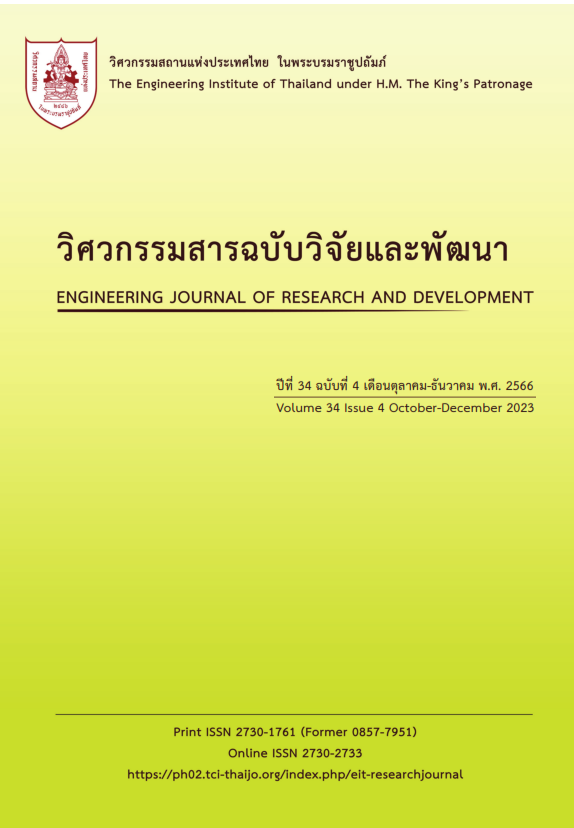COMPARISON OF THE VERTICAL POSITIONING ACCURACY OF DIGITAL SURFACE MODELS DERIVED FROM UAV PHOTOGRAMMETRY WITH VERTICAL GROUND CONTROL POINTS CREATED FROM LOCAL AND GLOBAL GEOID MODELS: IMPLICATIONS FOR PRELIMINARY HIGHWAY DESIGN IN GENTLE AND MOUNTAINOUS SLOPE AREAS OF NORTHEASTERN THAILAND
Main Article Content
Abstract
This study aimed to compare the vertical accuracy of digital surface models (DSMs) produced from unmanned aerial vehicle (UAV) photogrammetry using vertical ground control points calculated from local and global geoid models. The local geoid model applied was the Thailand Geoid Model 2017 (TGM2017), whereas the global geoid models used were EGM96 and EGM2008. This research was conducted within the context of preliminary highway engineering design, scrutinizing the accuracy across two distinctive terrains located in the Northeastern region of Thailand: (1) a gently sloping area situated in the Faculty of Engineering at Khon Kaen University, Khon Kaen Province, and (2) a mountainous slope located in the residential area of Chulabhorn Dam, Chaiyaphum Province. Ground control points were created by measuring using the static Global Navigation Satellite System (Static GNSS) method, complemented with network adjustment processing. At the same time, verification data were obtained from conventional topographic surveying. After processing UAV-derived imagery using each geoid model, the vertical accuracy of the DSMs and their resolution were evaluated. The study discovered noticeable differences in vertical accuracy dimensions between DSMs generated using TGM2017, EGM96, and EGM2008. Notably, at a 95 percent confidence level, the vertical accuracy of DSMs derived from TGM2017 did not exceed +/- 0.5 meters, while EGM96 and EGM2008 exceeded +/- 1.0 meters. These results demonstrated that DSMs using control points created from the TGM2017 model meet the vertical accuracy requirements for preliminary highway engineering design in the construction industry. The findings from this study provide invaluable insights into GNSS, photogrammetric surveying, and highway engineering. By emphasizing the superior performance of TGM2017 in UAV photogrammetry for preliminary highway design, it revealed the need for highly accurate local geoid models. These can help produce reliable and precise DSMs, sufficiently suitable for engineering projects that demand accurate positional data. Furthermore, this study underscores the need for continual refinement of UAV-based terrain mapping methods to keep up with improving construction industry standards amidst evolving technology.
Article Details

This work is licensed under a Creative Commons Attribution-NonCommercial-NoDerivatives 4.0 International License.
The published articles are copyright of the Engineering Journal of Research and Development, The Engineering Institute of Thailand Under H.M. The King's Patronage (EIT).
References
H, Eisenbeiß. et al. UAV photogrammetry, 2009, 18515.
I, Colomina. and P, Molina. Unmanned aerial systems for photogrammetry and remote sensing: A review, ISPRS J. Photogramm. Remote Sens, 2014, 92, pp.79–97. doi: 10.1016/j.isprsjprs.2014.02.013.
I, Elkhrachy. Accuracy Assessment of Low-Cost Unmanned Aerial Vehicle (UAV) Photogrammetry. Alexandria Eng. J, 2021, 60 (6), pp.5579–5590, 2021, doi: 10.1016/j.aej.2021.04.011.
F, Agüera-Vega. et al. Accuracy of digital surface models and orthophotos derived from unmanned aerial vehicle photogrammetry. J. Surv. Eng, 2017, 143 (2). doi: 10.1061/(ASCE)SU.1943-5428.0000206.
Federal Geographical Data Committee. Geospatial Positioning Accuracy Standards Part 3 : National Standard for Spatial Data Accuracy, Natl. Spat. Data Infrastruct, 1998, p.28. [Online]. Available: http://www.fgdc.gov/standards/projects/FGDC-standards-projects/accuracy/part3/chapter3.
คณะอนุกรรมการมาตรฐานการสำรวจด้วยอากาศยานไร้คนเพื่องานวิศวกรรม. มาตรฐานการสำรวจด้วยอากาศยานไร้คนเพื่องานวิศวกรรม, พิมพ์ครั้ง 1, 2565.
สมาคมวิศวกรรมสถานแห่งประเทศไทย ในพระบรมราชูปถัมภ์. รายงานฉบับสมบูรณ์ โครงการศึกษาเพื่อการพัฒนาวิชาชีพวิศวกรรม งบประมาณประจำปี 2558 โครงการศึกษาและจัดทำเกณฑ์การปฏิบัติวิชาชีพวิศวกรรมสำรวจ (The Study and Development of Code of Practices for Survey Engineer), 2558.
N, K. Pavlis. et al. The development and evaluation of the Earth Gravitational Model 2008 (EGM2008) J. Geophys. Res. Solid Earth, 2012, 117 (4). doi: 10.1029/2011JB008916.
F, G. Lemoine. et al. The Development of the NASA GSFC and NIMA Joint Geopotential Model, 1997, July, pp. 461–469. doi: 10.1007/978-3-662-03482-8_62.
P, Dumrongchai. International Transaction Journal of Engineering. Management , & Applied Sciences & Technologies Evaluation Of Tgm2017 For Height System Using Gnss / Leveling Data In Thailand, 2019, 10 (10), pp. 1–10. doi: 10.14456/ITJEMAST.2019.135.
มหาวิทยาลั ยเชียงใหม่. รายงานฉบับสมบูรณ์โครงการการพัฒนาแบบจำลองยีออยด์ความละเอียดสูงของประเทศไทย, (Development of Precise Geoid Model of Thailand) สิงหาคม, 2560.
P, Dumrongchai. and N, Duangdee. Evaluation Of Tgm2017 For Height System Using Gnss/Leveling Data In Thailand, 2019. doi: 10.14456/ITJEMAST.2019.135.
D. V. H. D.R. Cox, Theoretical Statistics, 1st Edition, 1974.


